11.06.2021
Rocket on pad, China ready to send 1st crew to space station
The rocket that will send the first crew members to China’s new space station has been moved onto the launch pad ahead of its planned blastoff next week
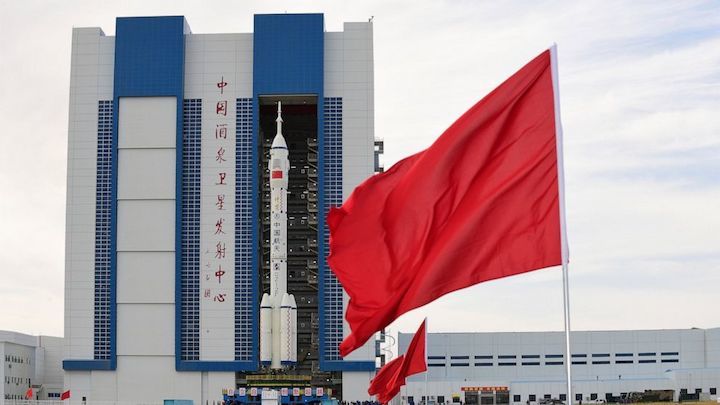
BEIJING -- The rocket that will send the first crew members to live on China's new orbiting space station has been moved onto the launch pad ahead of its planned blastoff next week.
The three astronauts plan to spend three months on the space station, far exceeding the length of any previous Chinese mission. They will perform spacewalks, construction and maintenance work and carry out science experiments.
The main section of the Tianhe, or Heavenly Harmony, station was launched into orbit on April 29. Cargo spacecraft sent up last month carried fuel, food and equipment to the station in preparation for the crewed mission.
The Long March-2F Y12 rocket carrying the Shenzhou-12 spaceship was transferred to the launch pad at the Jiuquan Satellite Launch Center in northwest China on Wednesday, the China Manned Space Engineering Office said in a brief statement. Its tentative launch date is next Wednesday.
The space agency plans a total of 11 launches through the end of next year to deliver two laboratory modules to expand the 70-ton station, along with supplies and crew members. Next week’s launch will be the third of those, and the first of the four crewed missions planned.
Another cargo mission is planned for September, shortly after which a replacement crew will be sent up, according to reports. The station's other two modules are expected to be launched next year.
China said in March the astronauts training for the upcoming crewed missions were a mix of space travel veterans and newcomers and included some women. China has sent 11 astronauts into space to date, all of them pilots from the ruling Communist Party’s military wing, the People’s Liberation Army.
The first Tianhe crew will be all male, though women will be part of future crews on the station, according to Yang Liwei, who orbited Earth in China’s first crewed mission in 2003 and is now an official at the space agency.
The Tianhe builds on experience China gained from operating two experimental space stations earlier in its increasingly ambitious space program. Chinese astronauts spent 33 days living on the second of the previous stations, carried out a spacewalk and taught science classes that were beamed down to students across the country.
China landed a probe, the Tianwen-1, on Mars last month that carried a rover, the Zhurong. It also has brought back lunar samples, the first by any country’s space program since the 1970s, and landed a probe and rover on the moon’s less explored far side.
Beijing doesn’t participate in the International Space Station, largely due to U.S. concerns over the Chinese program’s secrecy and its military connections. Despite that, foreign science missions and possibly foreign astronauts are expected to visit the Chinese station in future.
Once completed, the Tianhe will allow for stays of up to six months, similar to the much larger International Space Station.
The Chinese station reportedly is intended to be used for 15 years and may outlast ISS, which is nearing the end of its functional lifespan.
Quelle: abcNews
+++
China set to launch first astronauts to space station with Shenzhou-12
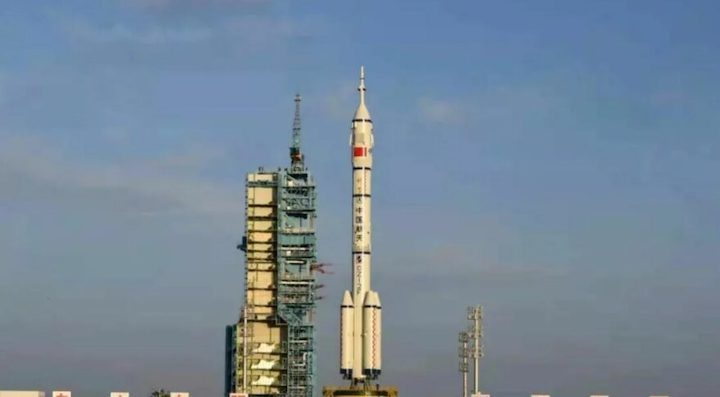
HELSINKI — China rolled out a Long March 2F rocket Wednesday in preparation to send the Shenzhou-12 spacecraft and three astronauts to an orbiting space station module.
The Long March 2F rocket was vertically transferred to its pad at the Jiuquan Satellite Launch Center in the Gobi Desert, the China Manned Space Engineering Office (CMSEO) announced Wednesday.
The rocket will send Shenzhou-12 and three astronauts to the Tianhe core module for China’s space station which launched April 28 Eastern.
Authorities have yet to reveal the planned launch date nor the identity of the primary and backup crews for the mission. Shenzhou-12 was expected to launch around June 10 Beijing time but a week-long delay to the launch of the Tianzhou-2 cargo mission likely pushed back the date by a similar length of time.
The Shenzhou-12 mission will involve a series of technical verification tasks related to the performance and function of the Tianhe core module. It will include extravehicular activities using EVA suits delivered by Tianzhou-2, and verification of a regenerative life support system.
Shenzhou-12 will be the country’s first crewed mission in more than four-and-a-half years and just the seventh overall. China’s first crewed mission was Shenzhou-5 in 2003 which made the country only the third to demonstrate independent human spaceflight capabilities.
The mission will see the first time since May 2000 that two orbiting space stations will be simultaneously inhabited, when STS-101 and Soyuz TM-30 visited the ISS and Mir respectively. Three Shenzhou flights to small Tiangong space labs took place in 2012, 2013 and 2016—concurrent with permanent ISS habitation—as stepping stone missions towards the larger space station modules.
Shenzhou-12 will also set a record for Chinese human spaceflight mission duration. The mission is expected to remain docked with Tianhe until September, meaning the roughly three-month mission will far exceed the 33-day record set by Shenzhou-11 in 2016.
The Long March 2F and Shenzhou spacecraft were developed to provide human spaceflight capabilities following the approval of “Project 921” in 1992. The plan also laid out the long term vision for a modular space station.
The 62-meter-long, 464-metric-ton Long March 2F consists of two stages and four side boosters. All of these use a propellant mix of highly toxic hydrazine and nitrogen tetroxide. The launcher features a launch escape system atop of the fairing, which relies on solid rocket motors.
The 16.6-meter-long, 4.2-meter-diameter Tianhe will provide regenerative life support and the main living quarters for astronauts as well as propulsion to maintain orbital altitude.
Chinese space station construction
Shenzhou-12 will be the third of 11 missions planned for the construction phase of the three-module Chinese space station across 2021 and 2022.
The Tianzhou-3 cargo spacecraft and Shenzhou-13 crewed mission will follow in September and October respectively.
Experiment modules named Wentian and Mengtian are expected to launch in 2022. The pair will host a plethora of experiments in areas including astronomy, space medicine, space life science, biotechnology, microgravity fluid physics, microgravity combustion and space technologies.
International science payloads will also fly to the space station, through cooperation between the United Nations Office for Outer Space Affairs (UNOOSA) and the CMSEO. Foreign astronauts are also expected to visit the CSS.
Both modules will be launched by Long March 5B rockets from Wenchang. The first stage of the Long March 5B that launched Tianhe entered orbit and made a high-profile, uncontrolled reentry.
The Chinese space station is expected to operate in orbit for at least ten years. It will be joined in orbit by the Xuntian optical module, a co-orbiting Hubble-class space telescope. The space telescope will have a 2-meter-aperture comparable to Hubble but feature a field of view 300 times greater.
This field of view will allow Xuntian to survey 40 percent of the sky across a decade using its 2.5 billion pixel camera
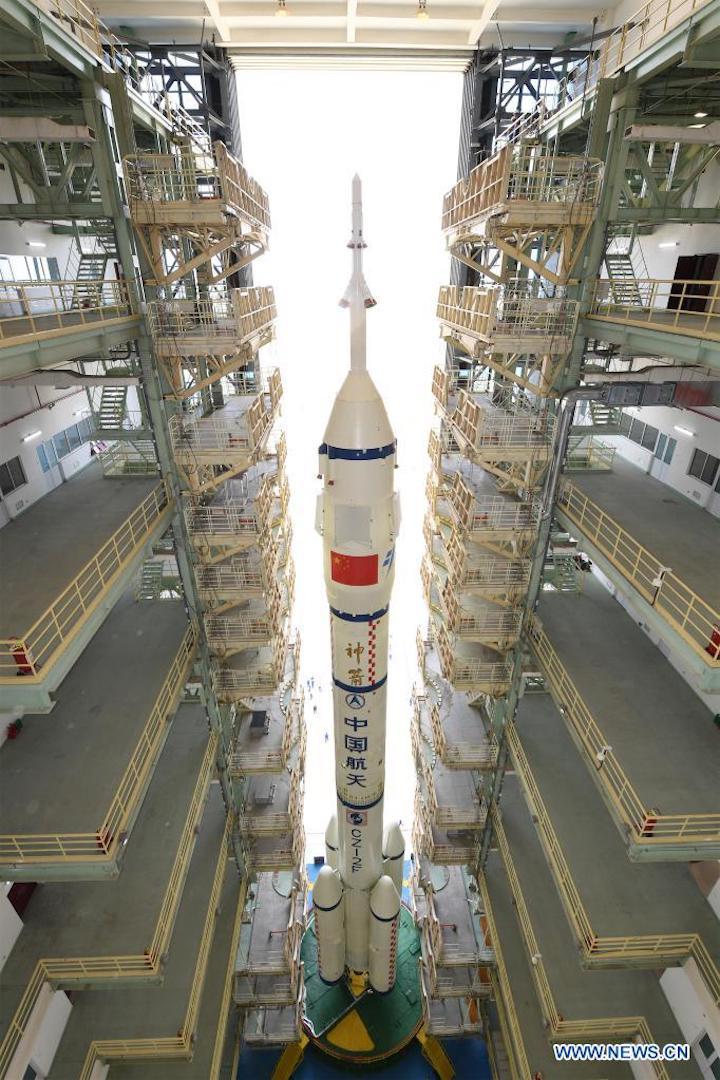
Quelle: SN
----
Update: 16.06.2021
.
Profile: Dream to come true for Chinese astronaut Tang Hongbo
Among the three crew members aboard the Shenzhou-12 spaceship, Tang Hongbo is a space rookie.
After preparing for over a decade, Tang's space dream is finally coming true.
CONFIDENCE, EXPECTATION
"I am very proud to be selected into the Shenzhou-12 spaceship crew," Tang said at a press conference on Wednesday.
"This is my first spaceflight mission, and pressure is inevitable," the 45-year-old astronaut said, "But after 11 years of learning, training and testing, I am full of confidence in myself and our team."
Born in 1975, Tang joined the People's Liberation Army in 1995 and clocked 1,159 hours of safe flight. He became a member of the second batch of Chinese astronauts in 2010.
He was selected as a backup crew member for Shenzhou-11 in 2016.
The Shenzhou-12 spaceship is expected to be launched on Thursday morning. This will be the first manned mission during the construction of China's space station, and the crew will stay in orbit for three months.
When asked about his expectation for this mission, he answered with a smile.
"I believe we crew members will work together to build the space station as our home in space. I also hope to meet with astronauts from other countries in the space station in the near future."
LONG PREPARATION
It has been 11 years since Tang was selected into the second batch of Chinese astronauts.
The second batch includes seven Chinese astronauts. Among them, Liu Yang, Wang Yaping and Chen Dong participated in space missions in Shenzhou-9, Shenzhou-10 and Shenzhou-11 respectively.
"When Liu, Wang and Chen flew into space, I asked myself when could I realize my space dream and use what I have learned?"
Tang told himself to "start from scratch," and keep training with devotion and diligence like a fresh trainee for his space dream.
"Tang is modest and always eager to learn. I have full confidence in this crew, and I trust Tang very much," said Nie Haisheng, another member of the Shenzhou-12 crew, which also include Liu Boming.
UNDERWATER CHALLENGE
In his training preparation, Tang was confident about his physical strength and endurance.
"I could get very tired during training, but I would always get over it."
In the underwater training designed for extravehicular activities (EVA), however, he met an unexpected challenge -- he was having a hard time getting used to the extravehicular spacesuit.
"I am not used to wearing a watch or hanging any additional things on my body. At the beginning of underwater training, I felt restless and just wanted to get rid of the suit right away."
The setback troubled him. "I have prepared for so many years, is this the end of it?"
Tang asked Liu Boming for advice. Liu told him that he had to overcome it by himself. He found some tricks, such as turning down the temperature inside the extravehicular suit to make himself calmer. He also learned psychological self-adjustment methods taught by the training center.
When Tang felt unbearable in the suit, he would take a break and used the techniques he learned to calm down. Then he would get back into the suit and continue training.
Gradually he was able to work in the extravehicular suit for hours without feeling uncomfortable.
"Tang is the most hardworking one in the second batch, very diligent in study and reliable in work. He will be a good help to us," said Liu Boming. Enditem
(Huang Ming, Li Guoli and Zhang Mimi also contributed to the story.)
+++
Profile: Chinese astronaut Nie Haisheng set for record-breaking space stay
Nie Haisheng is expected to soon create a record for the longest stay in space by a Chinese astronaut as he is slated to take part in his third space mission.
The commander of a three-man crew of the Shenzhou-12 manned spaceship, Nie, together with two teammates, will stay in orbit for three months, the longest in the country's manned space program.
The mission, scheduled to launch from the Jiuquan Satellite Launch Center on June 17, will make them the first crew to live and work in the country's space station core module Tianhe.
"We are honored to take the lead in a series of manned missions for the space station construction," Nie told media on Wednesday ahead of the launch. "We will make the core module a 'space home.'"
Nie, who has a doctoral degree, is one of China's most experienced astronauts. He has logged more than 19 days (470 hours) in space during his previous two missions.
But before he was nationally recognized as a space hero, Nie had put his life on the line for his country many times.
Born in 1964 in central China's Hubei Province, Nie comes from a humble financial background. He lived in a village with his six elder sisters and a younger brother doing farm work and studying until he turned 18. Nie had a great passion for planes and read a lot of books when he was a child, according to his classmates.
After graduating from high school, he was enrolled as a fighter pilot trainee by the People's Liberation Army Air Force in 1984.
In 1989, when he was flying a newly-modified plane alone, he encountered a sudden in-flight engine shutdown. Seeing the plane lose altitude rapidly, the ground commander ordered Nie to eject from the flight. But, he still tried to bring the plane back to safety risking his life. After all the attempts failed, he abandoned the flight and parachuted to safety when the plane was only four to five hundred meters above the ground. Following his narrow escape, Nie was awarded a third-class merit citation for his extraordinary courage.
Nearly a decade after the incident, Nie joined the country's first team of astronauts, receiving training much tougher than that for a fighter pilot. He stood out and was selected as one of the final three candidates for China's first manned space mission in 2003, which sent astronaut Yang Liwei into space.
On Oct. 12, 2005, his efforts were put to the test as Shenzhou-6 spacecraft lifted off from the Jiuquan Satellite Launch Center in northwest China.
He celebrated his 41st birthday during the space mission. His wife and daughter were brought to the Beijing Aerospace Control Center to send him birthday wishes.
State television showed his 11-year-old daughter singing "Happy Birthday" to him through radio which moved Nie to tears.
The astronaut said his success would not have been possible without the support of his family.
Nie was slightly overweight when he started training as an astronaut. His wife and daughter worked out with him and took care of the diet. His daughter often complained: "No good meal when dad stays at home."
Nie was initially not good at English, but his daughter was gifted with language skills. She always practiced with him and corrected his mistakes as a little teacher.
Nie loves fishing and is a terrific cook. His wife said Nie always treats the family with delicious fish delicacies.
Yang Liwei, China's first astronaut entering space, described Nie as being "persistent, dauntless and prudent." "He doesn't talk much. He is a hard-working and cooperative person," Yang said.
During his 15-day space trek on Shenzhou-10 in 2013, Nie, who held the rank of Major General, conducted the manual space docking in the mission. Nie's success can be attributed to his tough training, as he has conducted more than 2,000 ground simulations achieving 100 percent accuracy in manual docking.
"Nie is strict with himself," female astronaut Wang Yaping of the Shenzhou-10 mission once said in an interview. "With him, we have nothing to worry about."
Two space missions brought him a host of accolades, including the title of "Hero Astronaut" and an asteroid named after him for his excellent work.
The 56-year-old space traveler still has the drive and enthusiasm of an astronaut half his age.
"The oldest astronaut in the world to ever travel in space is 77 years old, so I am still young," Nie said with a grin. "As long as my health permits, I am looking forward to undertaking more space missions." Enditem
+++
China to expand int'l cooperation on space station
China plans to carry out more extensive and in-depth international cooperation on its space station, making it a space lab for the benefit of all mankind, according to the China Manned Space Agency (CMSA) on Wednesday.
China plans to deepen cooperation concerning the function expansion of the space station, space science and applications, joint flight of Chinese and foreign astronauts, and transformation of technological achievements, said Ji Qiming, assistant to the CMSA director, at a press conference.
The scientific experiment cabinets aboard China's space station have been equipped with standard ports for diversified payloads to carry out international research, said Ji.
In March 2016, the CMSA and the United Nations Office for Outer Space Affairs (UNOOSA) signed a memorandum of understanding to invite UN member states to conduct scientific experiments aboard China's space station. In May 2018, 27 countries brought forward 42 cooperation proposals after the two agencies sent out the invitation.
In June 2019, China released the first batch of nine jointly-selected international cooperation projects, involving 17 countries in aerospace medicine, life sciences and biotechnology, microgravity physics and combustion science, astronomy, and other emerging technologies.
China has been cooperating with France, Italy and Pakistan on space experiments in fields like basic physics, space medicine and space astronomy.
Ji noted that China and Russia have maintained sound and productive cooperation in the crewed spaceflight field. Both sides are maintaining exchanges in low-Earth orbit space station and crewed deep space exploration, and more cooperation is expected.
He added that China and Russia will have more joint experimental projects to make due contributions to the exploration of outer space for mankind.
As for the joint flight of Chinese and foreign astronauts, many countries and regions have expressed the willingness to cooperate with China, said Ji.
"We welcome cooperation in this regard in general," he said, "It is believed that, in the near future, after the completion of the Chinese space station, we will see Chinese and foreign astronauts fly and work together." Enditem
+++
China unveils Shenzhou-12 astronauts for space station construction
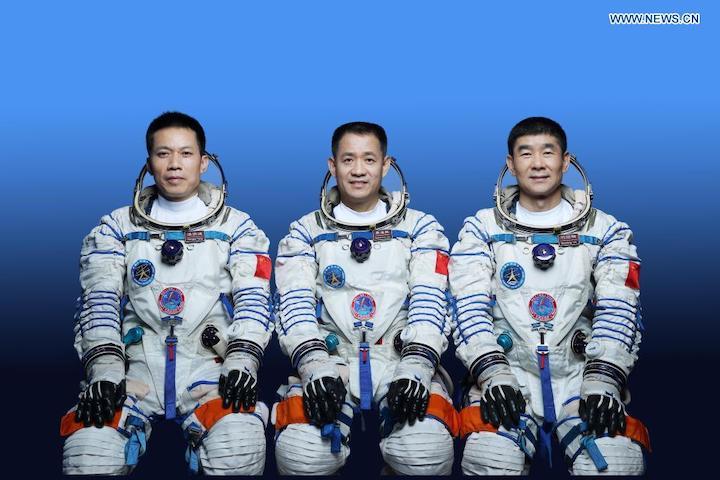
This undated photo shows Chinese astronauts Nie Haisheng (C), Liu Boming (R) and Tang Hongbo who will carry out the Shenzhou-12 manned spaceflight mission. (Photo by Xu Bu/Xinhua)
Chinese astronauts Nie Haisheng, Liu Boming and Tang Hongbo will carry out the Shenzhou-12 manned spaceflight mission, and Nie will be the commander, the China Manned Space Agency (CMSA) announced on Wednesday.
This will be the first manned mission during the construction of China's space station, and the crew will stay in orbit for three months, Ji Qiming, assistant to the director of the CMSA, told a press conference held at the Jiuquan Satellite Launch Center, where the Shenzhou-12 spaceship will be launched on Thursday morning.
Nie, the most experienced among the three, was in the Shenzhou-6 mission in 2005 and the Shenzhou-10 mission in 2013.
It will be Liu's second spaceflight, as he once participated in the Shenzhou-7 mission in 2008, which featured a landmark spacewalk.
Tang will be a newcomer to space. He became a member of the second batch of Chinese astronauts in 2010.
Zhai Zhigang, Wang Yaping and Ye Guangfu will be the backup crew, Ji said.
The Shenzhou-12 spaceship will conduct a fast autonomous rendezvous and docking with the space station core module Tianhe and form a complex with Tianhe and the cargo craft Tianzhou-2.
China launched Tianhe on April 29 and Tianzhou-2 on May 29. The two completed a computer-orchestrated rendezvous and docking on May 30, waiting for the first crewed mission to unpack the cargo.
TOUGHER TASKS
The Shenzhou-12 astronauts are expected to set a new record for China's manned space mission duration and their work is also more complicated and challenging than previous crewed missions, said CMSA director Hao Chun.
According to Ji, in the Shenzhou-12 mission, the crew will complete four major tasks in orbit.
First, they will operate and manage the complex, including the in-orbit test of the Tianhe module, validation of the recycling and life support system, testing and operation training of the robotic arm, as well as management of materials and waste.
Second, they will move, assemble and test extravehicular spacesuits and perform two extravehicular activities for work including assembling an extravehicular toolbox, lifting the panoramic camera and installing extended pump sets.
Third, they will carry out space science experiments and technology experiments, as well as public outreach activities.
Fourth, they will manage their own health through daily life care, physical exercise, and regular monitoring and assessment of their own health status.
The astronauts have all carried out solid ground training and mission preparation under comprehensive training programs and plans, Ji said.
COLORFUL SPACE LIFE
The Tianhe module will provide the astronauts three times as much space as what was available in the Tiangong-2 space lab, with three independent bedrooms and one bathroom.
Meanwhile, the astronauts can choose from more than 120 kinds of space food that not only taste good but provide balanced nutrition with a long shelf-life.
The dining area is equipped with food heating device, refrigerator, water dispenser and folding table. In the exercise area, the treadmill and spin bike provide them exercise to maintain physical health.
The two-way video communication and e-mails between the station and ground control will be realized through the space communication link and video communication equipment.
Compared with previous crewed missions, the core module of the space station is, for the first time, equipped with a life support system, including subsystems for electrolytic oxygen generation, condensate water collection and treatment, urine treatment, carbon dioxide removal, and the removal of trace amounts of harmful gas to ensure the long-term in-orbit stay of astronauts, Ji said. Enditem
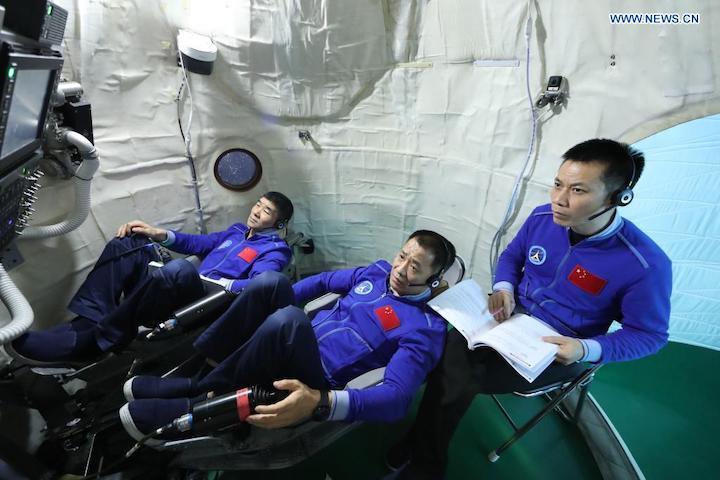
Chinese astronauts Nie Haisheng (C), Liu Boming (L) and Tang Hongbo are seen during a training on May 15, 2021. Chinese astronauts Nie Haisheng, Liu Boming and Tang Hongbo will carry out the Shenzhou-12 manned spaceflight mission, and Nie will be the commander, the China Manned Space Agency (CMSA) announced on Wednesday. The astronauts have all carried out solid ground training and mission preparation under comprehensive training programs and plans, according to Ji Qiming, assistant to the director of the CMSA. (Photo by Xu Bu/Xinhua)
China to launch Shenzhou-12 manned spaceship on June 17
The Shenzhou-12 manned spaceship is expected to be launched at 9:22 a.m. Thursday (Beijing Time) from the Jiuquan Satellite Launch Center in northwest China, announced the China Manned Space Agency (CMSA) on Wednesday.
The spaceship will take three male astronauts -- Nie Haisheng, Liu Boming and Tang Hongbo -- into space for the construction of China's space station, said Ji Qiming, assistant to the director of the CMSA, at a press conference held at the launch center.
After entering orbit, the spaceship will conduct a fast automated rendezvous and docking with the in-orbit space station core module Tianhe, forming a complex with the core module and the cargo craft Tianzhou-2. The astronauts aboard Shenzhou-12 will be stationed in the core module and remain in orbit for three months.
The launch will be carried out with a Long March-2F carrier rocket, which will be filled with propellant on Wednesday morning, Ji said.
China launched the space station core module Tianhe on April 29 and the cargo spacecraft Tianzhou-2 on May 29. According to Ji, the complex of the two spacecraft has been in good condition, with all equipment operating normally.
The complex has moved into an orbit at an altitude of 390 kilometers, ready for the rendezvous and docking as well as the entry of the astronauts, Ji said.
All systems conducting the Shenzhou-12 mission have undergone the comprehensive rehearsal, the crew is in good shape, and all pre-launch preparations are in order, Ji added. Enditem
Quelle: Xinhua
----
Update: 17.06.2021
.
Shenzhou-12 manned spaceship launched in northwest China
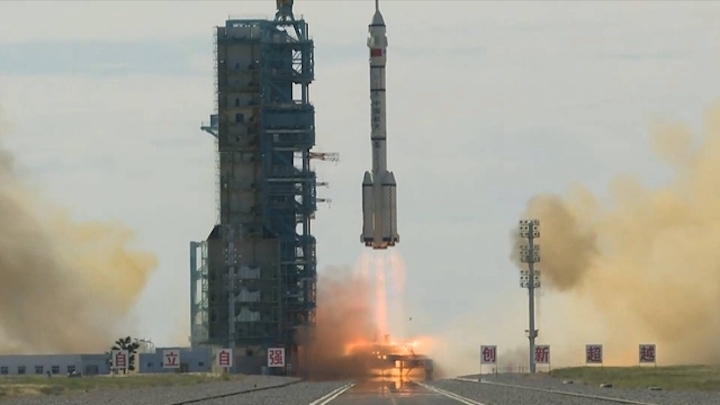
The Shenzhou-12 manned spaceship was launched Thursday (Beijing Time) from the Jiuquan Satellite Launch Center in northwest China.
The crew will stay in orbit for three months for the construction of China's space station
Quelle: Xinhua
----
Update: 18.06.2021
.
Chinese crew enters new space station on 3-month mission
Three Chinse astronauts have arrived at China's new space station at the start of a three-month mission, marking a milestone in the country's ambitious space program

JIUQUAN, China -- Three Chinese astronauts arrived Thursday at China's new space station at the start of a three-month mission, marking another milestone in the country’s ambitious space program.
Their Shenzhou-12 craft connected with the space station module about six hours after taking off from the Jiuquan launch center on the edge of the Gobi Desert.
About three hours later, commander Nie Haisheng, 56, followed by Liu Boming, 54, and space rookie Tang Hongbo, 45, opened the hatches and floated into the Tianhe-1 core living module. Pictures showed them busy at work unpacking equipment.
“This represents the first time Chinese have entered their own space station,” state broadcaster CCTV said on its nightly news broadcast.
The crew will carry out experiments, test equipment, conduct maintenance and prepare the station for receiving two laboratory modules next year. The mission brings to 14 the number of astronauts China has launched into space since 2003, becoming only the third country after the former Soviet Union and the United States to do so on its own.
All appears to have gone smoothly so far. China's leaders hope the mission will be a complete success as the ruling Communist Party prepares to celebrate the centenary of its founding next month.
The astronauts were seen off by space officials, other uniformed military personnel and a crowd of children waving flowers and flags and singing patriotic songs before blasting off at 9:22 a.m (0122 GMT) atop a Long March-2F Y12 rocket.
The rocket dropped its boosters about two minutes into the flight followed by the cowling surrounding Shenzhou-12. After about 10 minutes it separated from the rocket's upper section, extended its solar panels and shortly afterward entered orbit.
About a half-dozen adjustments took place over the following six hours to line up the spaceship for docking with the Tianhe-1, or Heavenly Harmony, module at about 4 p.m. (0800 GMT).
The travel time is down from the two days it took to reach China's earlier experimental space stations, a result of a “great many breakthroughs and innovations," the mission’s deputy chief designer, Gao Xu, told state broadcaster CCTV.
“So the astronauts can have a good rest in space which should make them less tired," Gao said.
Other improvements include an increase in the number of automated and remote-controlled systems that should “significantly lessen the pressure on the astronauts," Gao said.
Two astronauts on those past missions were women, and while this first station crew is all male, women are expected to be part of future station crews.
The mission is the third of 11 planned through next year to add the additional sections to the station and send up crews and supplies. A fresh three-member crew and a cargo ship with supplies will be sent in three months.
China is not a participant in the International Space Station, largely as a result of U.S. objections to the Chinese programs secrecy and close military ties. However, China has been stepping up cooperation with Russia and a host of other countries, and its station may continue operating beyond the International Space Station, which is reaching the end of its functional life.
China landed a probe on Mars last month that carried a rover, the Zhurong, and earlier landed a probe and rover on the moon's less explored far side and brought back the first lunar samples by any country’s space program since the 1970s.
China and Russia this week also unveiled an ambitious plan for a joint International Lunar Research Station running through 2036. That could compete and possibly conflict with the multinational Artemis Accords, a blueprint for space cooperation that supports NASA’s plans to return humans to the moon by 2024 and to launch an historic human mission to Mars.
After the Tianhe-1 was launched in April, the rocket that carried it into space made an uncontrolled reentry to Earth, though China dismissed criticism of the potential safety hazard. Usually, discarded rocket stages reenter the atmosphere soon after liftoff, normally over water, and don’t go into orbit.
The rocket used Thursday is of a different type and the components that will reenter are expected to burn up long before they could be a danger, said Ji Qiming, assistant director of the China Manned Space Agency.
Quelle: abcNews
+++
Three astronauts will be first to board new Chinese space station
 The Shenzhou 12 crew is commanded by Nie Haisheng (center). Nie is joined by Liu Boming (right) and Tang Hongbo (left). Credit: Xinhua
The Shenzhou 12 crew is commanded by Nie Haisheng (center). Nie is joined by Liu Boming (right) and Tang Hongbo (left). Credit: Xinhua
Two veteran Chinese astronauts and a first-time space flier will be the first crew members to live and work aboard China’s new space station after launching Wednesday from a remote spaceport in the Gobi Desert.
Chinese officials announced the identities of the three-man crew — all experienced fighter pilots in the Chinese Air Force — for the Shenzhou 12 mission in a press conference early Wednesday, less than 24 hours before the scheduled launch from the Jiuquan space base in northwestern China’s Inner Mongolia region.
The launch aboard a Long March 2F rocket is scheduled for 9:22 p.m. EDT Wednesday (0122 GMT; 9:22 a.m. Beijing time Thursday), China’s space agency said in a statement.
About six hours later, the spacecraft will dock with the forward end of the space station’s Tianhe core module orbiting around 240 miles (390 kilometers) above Earth. After equalizing pressure, the astronauts will open hatches and enter the space station for the first time.
“All systems conducting the Shenzhou 12 mission have undergone a comprehensive rehearsal,” said Ji Qiming, assistant to the director of the China Manned Space Agency. “The flight crew is in good shape and all the pre-launch preparations are in order.”
Nie Haisheng, a 56-year-old veteran of two previous Shenzhou missions in 2005 and 2013, leads the three-man crew. Nie logged more than 19 days in orbit on his first two spaceflights.
The other two Shenzhou 12 crew members are Liu Boming and Tang Hongbo.
Liu, 54, participated in the first spacewalk for China’s space program on the Shenzhou 7 mission in 2008. Tang is 45 years old and will make his trip into space on Shenzhou 12.
The three astronauts will spend about three months on the Tiangong space station, performing spacewalks, operating the lab’s robotic arm, and activating the Tianhe module’s living quarters.
The first element of the space station, the Tianhe core module, launched April 28 aboard a heavy-lift Long March 5B rocket, China’s most powerful launch vehicle. An unpiloted cargo ship, named Tianzhou 2, launched May 29 and docked with the Tianhe core module eight hours later, delivering fuel, food and spacesuits for the Shenzhou 12 astronauts.
The Shenzhou 12 mission will mark the longest stay in space to date by Chinese astronauts. Shenzhou 12 will be China’s seventh crewed spaceflight since 2003, but the first since 2016.
The Tianhe core module and the Tianzhou 2 cargo ship are in a “stable status” and ready for arrival of the Shenzhou 12 crew, Ji said in a press conference.
Ground crews at Jiuquan planned to load storable hydrazine and nitrogen tetroxide propellants into the Long March 2F rocket ahead of launch Wednesday. The toxic propellant mixture will feed the rocket’s engines, which will produce about 1.4 million pounds of thrust at liftoff.
A few hours before liftoff, Nie and his two crewmates will board the Shenzhou 12 spacecraft on top of the 191-foot-tall (58-meter) Long March 2F rocket.

The launcher will deliver the Shenzhou 12 spacecraft to a preliminary orbit less than 10 minutes after launch. The capsule will unfurl solar panels to generate electricity, then begin firing thrusters to catch up with the Tianhe core module. The rendezvous and docking is planned to be fully automated, according to Chinese officials.
After boarding the Tiangong space station, the Shenzhou 12 astronauts will unpack the Tianzhou 2 cargo ship docked at the core module’s aft port. The entire complex will stretch nearly 120 feet (about 36 meters) long.
There are more than 120 kinds of food staged at the space station for the Shenzhou 12 astronauts, officials said. The galley includes a device to heat food, a refrigerator, water dispenser, and a folding table.
While China’s space station is still under construction, the Tianhe core module already in orbit includes astronaut living quarters, medical equipment, a command and control element, and an airlock and exterior handrails for spacewalks. There are three sleeping compartments — one for each astronaut — and one toilet on the Tianhe core module, Chinese officials said.
The core module of the Chinese space station also has a treadmill and a stationary bicycle for astronauts to get some exercise.
The Shenzhou 12 astronauts will perform two spacewalks outside the Tianhe module during their three-month mission, and test out the space station’s robotic arm, Ji said
The crew will also test the space station’s regenerative life support system, which produces breathing oxygen through electrolysis and recycles urine to generate drinking water.
“This way, we have closed-loop resource to draw upon which can greatly reduce dependence on ground supplies, and of course increase the economic efficiency of the space station,” said Zhou Jianping, chief designed for China’s human spaceflight program.
The Shenzhou 12 astronauts are scheduled to return to Earth in September for a parachute-assisted landing in China’s Inner Mongolia province. The landing will target a new recovery zone near the Jiuquan spaceport.
Around the same time, China will launch Tianzhou 3, the station’s next cargo resupply ship.
Tiangong means heavenly palace in Chinese, while Shenzhou is translated as divine vessel. Tianhe means heavenly harmony, and Tianzhou means heavenly vessel.
China’s next crewed spaceflight, Shenzhou 13, is scheduled to launch in October, carrying three astronauts for a six-month mission in orbit, according to the China Manned Space Agency.
Next year, China plans six more launches to support the space station program. Two Long March 5B rockets will boost the Wentian and Mengtian lab elements to dock with the Tianhe module, completing assembly of the three-segment, T-shaped space station.

There are also two more cargo spacecraft and two more Shenzhou crew capsules scheduled to launch to the space station in 2022.
The fully-assembled Chinese space station outpost will be around 66 metric tons, about one-sixth the mass of the International Space Station, and closer in size to Russia’s retired Mir station. With cargo and crew vehicles temporarily docked, the Chinese station’s mass could reach nearly 100 metric tons, officials said.
China launched two Tiangong prototype space labs in 2011 and 2016 to test out technologies for the permanently-occupied space station. The Tiangong 1 space lab hosted two Shenzhou crews in 2012 and 2013. China’s most recent human spaceflight mission — Shenzhou 11 — docked with the Tiangong 2 module in 2016.
In total, China has launched 11 astronauts into orbit on six crewed Shenzhou missions since 2003.
Quelle: SN
+++
Reentry von Shenzou12 Long March-2FY12 Booster-Rakete



Chinesisches Bergeteam für Reentry-Debris


Quelle: Twitter

